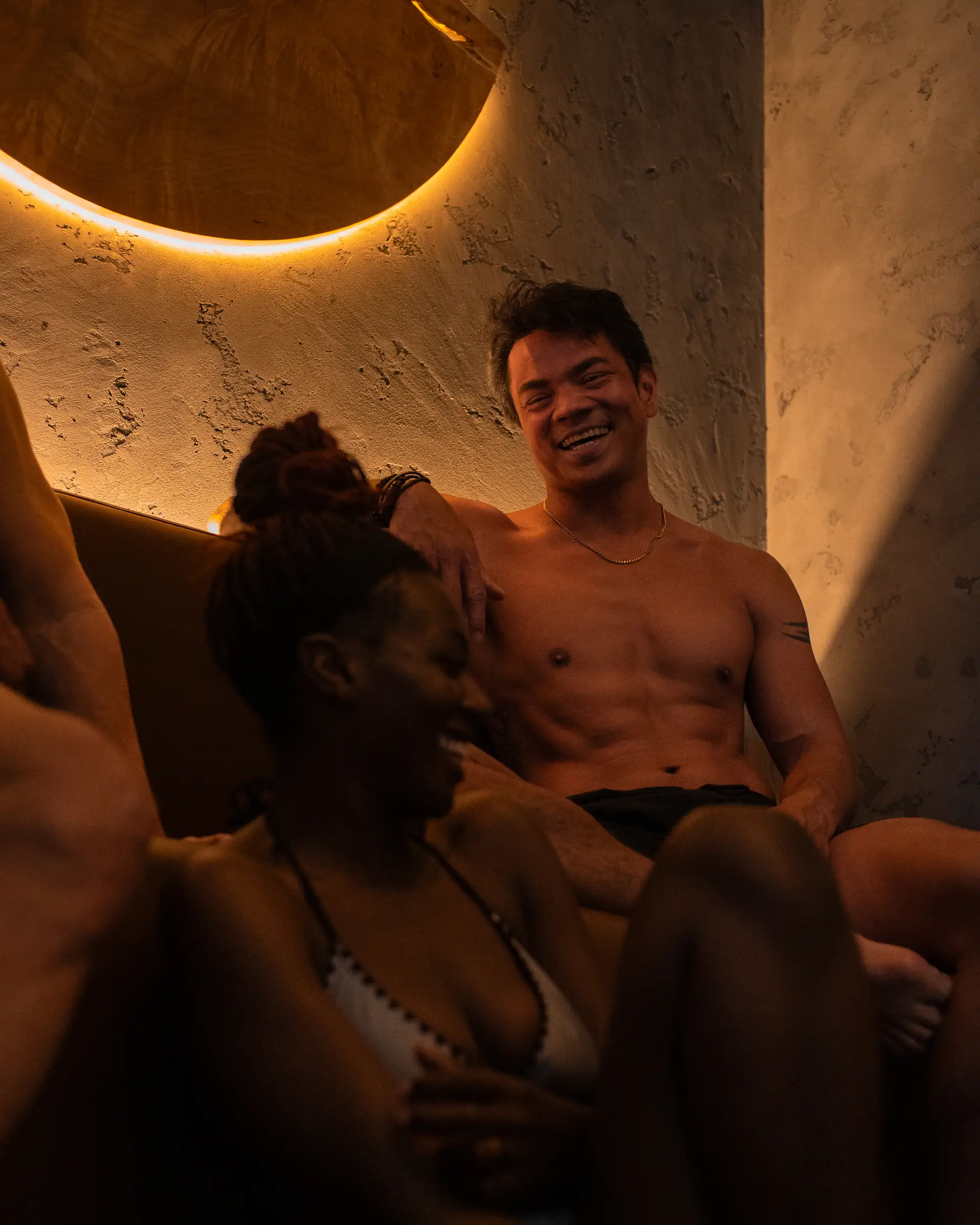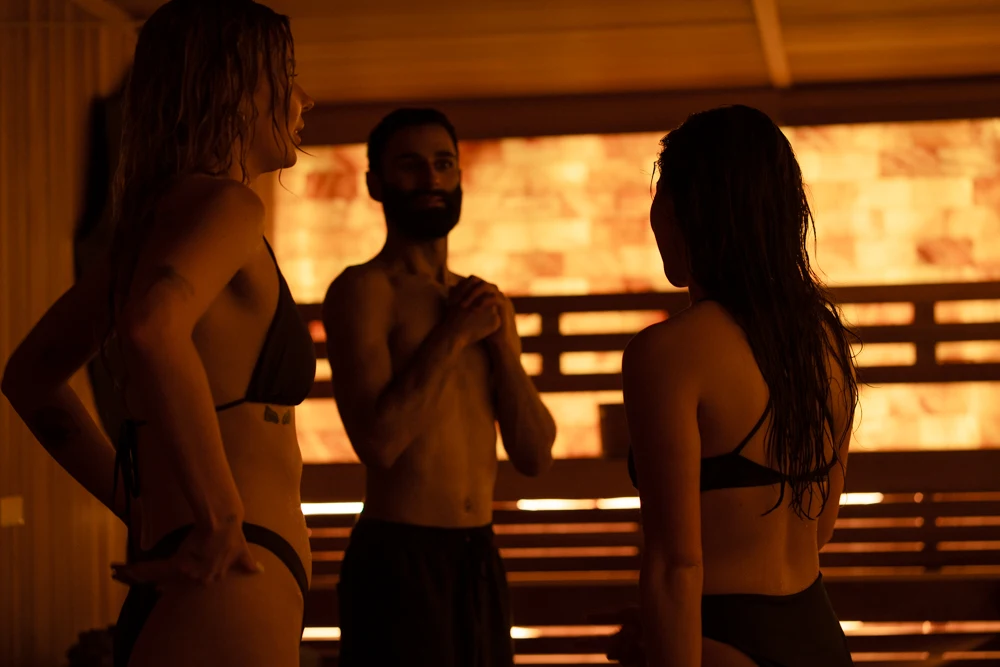TL;DR - Key Takeaways
- Sauna culture is deeply rooted in Finland, where it is recognized by UNESCO as Intangible Cultural Heritage, reflecting its role as a shared social and cultural practice (UNESCO, 2020).
- Group sauna use enhances relaxation, social bonding, and emotional balance through shared ritual and communal identity (Newson, 2025).
- Warmth, collective rhythm, and synchronized breathing in shared heat spaces may engage social neurobiology (e.g. oxytocin pathways) that support empathy and cooperation (Neuroscience & Biobehavioral Reviews, 2013).
- At AetherHaus, communal formats such as social session and haus classic bring this tradition to modern Vancouver life.
- A global sauna survey found that frequent sauna users more often report improved clarity and emotional steadiness and reduced stress, suggesting communal sauna culture supports psychological resilience (Journal of Global Health / Preventive Medicine Report, 2019).
Introduction
Inside a sauna, the world slows down. The body warms. Breath softens. What remains is presence and people.
Across cultures, the sauna has always been a communal space. From Finnish villages to Indigenous sweat lodges, it has been a place for stories, silence, and restorationl. At AetherHaus, this heritage continues in Vancouver through shared heat and quiet ritual, designed not only for recovery but for reconnection.
A Shared History of Heat
The Communal Origin
In Finland, traditional smoke saunas (savusauna) were once central to family life, serving as spaces for birth, cleansing, and preparation for important life events. This heritage is part of the reason sauna culture is recognized by UNESCO as Intangible Cultural Heritage (UNESCO, 2020).
Similar spaces appeared across northern and eastern Europe: the Estonian leil, the Russian banya, and the Latvian pirts. Each blended heat, steam, and community, built on the belief that warmth unites people and renews the rhythm of communal life. (Wikipedia).
This tradition continues at AetherHaus in Vancouver, where sauna is reimagined not as escape but as return; a place to breathe beside others in shared silence.
Sauna as a Social Equalizer
In traditional settings, the sauna functioned as a “level ground” - within its steam and simplicity, everyone entered on equal terms. Public saunas have been described as safe “third spaces,” where formal titles and social standing fall away and individuals experience social equality and belonging (University of Vaasa, 2024).
This sense of equality endures today. In a world that often celebrates separation, the sauna remains one of the few environments that naturally invites connection without pretense.

The Science of Connection
Heat and Human Bonding
Heat does more than relax muscles. It builds trust. Shared warmth and synchronized breathing may engage the brain’s social bonding systems, with oxytocin playing a central role in enhancing empathy, cooperation, and calm regulation (Neuroscience & Biobehavioral Reviews, 2013).
Participation in guided group sauna experiences, especially when structured with rhythm and periods of silence, can amplify positive emotional states and reduce perceived stress via collective focus and intentional pacing (Newson, 2025).
These studies confirm what ancient cultures already practiced: shared heat strengthens human connection, both psychologically and biologically.
Shared Stillness and Neural Calm
When people engage in shared heat or rhythmic environments, their neural and physiological rhythms may tend to synchronize- an effect called neural entrainment that fosters alignment in attention and relaxation (Department of Education, “Roma Tre” University, 2024).
This may explain why communal sauna feels more restorative than solitary use. The body rests while the collective atmosphere deepens focus. In that shared stillness, community is not forced, it emerges naturally.
Designing for Togetherness at AetherHaus
Spatial Philosophy
The Haus was built for quiet gathering. Circular benches, cedar interiors, and soft lighting invite inclusion without expectation. Each person sits within the same field of heat, part of a balanced whole rather than a divided space.
The architecture encourages closeness without crowding, reflection without isolation. It honours sanctuary and social connection in equal measure.
Guided Experiences That Foster Connection
AetherHaus offers both free-flow and guided sessions designed to cultivate shared calm:
- social session - unstructured space for community connection through shared warmth.
- haus classic - a flowing sequence of sauna and cold immersion for collective renewal.
- the pause - shared silence that invites grounding and reflection.
- the chill - a guided contrast practice focused on presence and recovery.
Each session brings people together in a rhythm of breath and warmth that redefines what community feels like.
Sauna as a Modern Sanctuary
The Role of Shared Ritual
In urban settings like Vancouver, isolation often replaces connection. Communal sauna rituals provide a way back to shared experience, an intentional space where conversation becomes optional and belonging becomes effortless.
Researchers conducting the Global Sauna Survey found that regular sauna use is widely associated with relaxation, stress reduction, and improved emotional resilience; suggesting that communal sauna culture can strengthen psychological steadiness and support social connection (Journal of Global Health / Preventive Medicine, 2019).
At AetherHaus, this principle guides every design decision. The goal is not to entertain but to allow human presence to settle, naturally and quietly, within shared heat.
A Vancouver Reflection
In Vancouver, framed by ocean air and mountain mist, community often hides behind pace and productivity. The warmth of AetherHaus counters that rhythm.
Here, solitude softens. Guests share breath, space, and stillness. In the quiet, they rediscover the simple comfort of being together without the need to speak.
Conclusion
Sauna is not only about heat. It is about belonging.
Each shared inhale becomes a reminder of connection- a soft exchange of presence that transcends words.
At AetherHaus, warmth becomes community. Within its cedar walls, stillness turns into language, and presence turns into care.
Join this collective experience through guided sessions or book a session to rediscover the rhythm of shared calm in Vancouver.

FAQ
Why are saunas traditionally communal? Communal saunas allowed people to connect, share stories, and equalize social boundaries across cultures; especially in Finland, where it is recognized by UNESCO as Intangible Cultural Heritage (UNESCO, 2020).
Can communal sauna improve emotional balance? Yes. Large-scale survey research shows that regular sauna use is linked to reduced stress and better mental health, while social bonding in group rituals is supported by oxytocin pathways that foster trust and connection (Journal of Global Health / Preventive Medicine, 2019).
How does AetherHaus foster community in its design? Through circular seating, gentle lighting, and intentional pacing that encourage shared focus and ease.
Is conversation encouraged during sessions? In some, yes. social session welcomes dialogue, while others such as the pause invite shared silence.
What can I expect from joining a communal sauna practice? A feeling of connection, grounding, and calm. Within shared heat, separation fades and community becomes experience.
